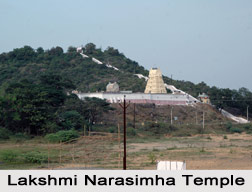 Sri Lakshmi Narasimha Temple is one of the significant temples in Pazhaiya Seevaram. The temple is situated picturesquely on a small hill in the tiny village of Pazhaiya Seevaram on the northern bank of the river Palar. The temple represents antiquity and traditionality as its essential features.
Sri Lakshmi Narasimha Temple is one of the significant temples in Pazhaiya Seevaram. The temple is situated picturesquely on a small hill in the tiny village of Pazhaiya Seevaram on the northern bank of the river Palar. The temple represents antiquity and traditionality as its essential features.
The shrine Sri Lakshmi Narasimha Temple is situated in the ancient Pallava territory of Tondaimandalam. The place is about seventy kilometers from Chennai and is located on the Chengalpattu -Kanchipuram highway. The large and captivating image of the main deity of this temple, Sri Lakshmi Narasimha is the chief attraction of the temple. The deity of Sri Lakshmi Narayana is found in a seated posture, holding Lakshmi on His left lap, with His right hand in abhaya hasta, offering protection to His devotees.
Legend of Sri Lakshmi Narayana Temple
The legendary story associated with the temple added grandeur to the antiquity of the temple. According to the legend connected with this temple, this place was originally known as Satyavrata Kshetram. The name given to this hill was Padmagiri. Sage Atri performed penance here and in response to his prayer, Lakshmi Narasimha appeared before him in His benign (prasanna) form and was worshiped here by Atri Maharishi. The Sthala-purana of this place, called Padmagiri Mahatmyam, which is found in the section on Archavatara in the Brahmanda Purana. Thus the legend associated with the temple signifies the antique significance of Sri Lakshmi Narayana Temple.
Architecture of Sri Lakshmi Narayana Temple: - The image of the deity, adorned with the flag-staff (dvajastambha) in front with His consort, Ahoballavalli Thayar reveals the architectural excellence of the artists of the contemporary era.
Festivals of Sri Lakshmi Narayana Temple: - The festivals observed in the temples reflect the cultural heritage of the temple. A number of festivals are observed in the temple with grandeur and enormous splendor.
Inscriptions of Sri Lakshmi Narayana Temple: - The inscription stamped on the walls depicts the chronology of the temple and also point to the achievements of the kings of the contemporary period. They also record the benefactions made by these kings to this temple.





















